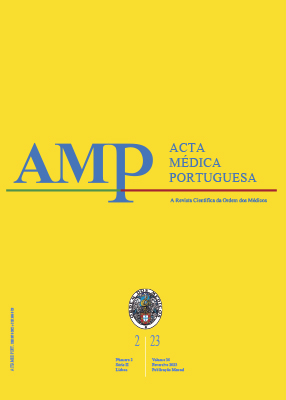Salmonellosis in Children at a Portuguese Hospital: A Retrospective Study
DOI:
https://doi.org/10.20344/amp.18906Keywords:
Child, Portugal, Salmonella enterica, Salmonella Infections, Typhoid FeverAbstract
Introduction: Salmonellosis represents a considerable health, social and economic burden in both high- and low-income countries. Recently, in Portugal, most cases of Salmonella infections have been reported in children under 15 years of age. The main aim of this study was to characterize, from an epidemiological, microbiological, and clinical perspective, cases of Salmonella isolation among children.
Material and Methods: The authors performed a descriptive study using retrospective analysis of cases of salmonellosis, in pediatric age, at a Portuguese Level II Hospital, between January 2015 and July 2020.
Results: The population included a total of 63 children, of which 81% were Portuguese. Ethnicity was identified in 13 children, most of whom were African. The median age at diagnosis was four years old (3.5 - 9 years old). Despite the small number of cases per year in our study (11), one-third were severe enough to require hospitalization. Overall, 13% of patients were treated with antibiotics. In 63% of the isolates, serotype was identified: Salmonella Enteriditis (38%), Salmonella Typhimurium (22%), and Salmonella Typhi (3%). Antibiotic resistance rates were 19% for ampicillin and 6.4% for amoxicillinclavulanic acid and cotrimoxazole. No resistance to third-generation cephalosporins was found.
Conclusion: Given the obtained results, we intend to improve knowledge on salmonellosis in Portugal and, consequently improve prevention strategies, treatment and its notification. Although the incidence of salmonellosis has been decreasing in recent years it is the second most frequent gastrointestinal infection in the European Union, contributing to significant rates of hospitalizations and use of antibiotics in Portugal.
Downloads
References
Wen SC, Best E, Nourse C. Non-typhoidal Salmonella infections in children: review of literature and recommendations for management. J Paediatr Child Health. 2017;53:936-41. DOI: https://doi.org/10.1111/jpc.13585
Pinto CS, Bordalo A, Albuquerque MJ, Nascimento M, Vicêncio PO. Doenças de declaração obrigatória 2011-2014. Lisboa: Direção-Geral da Saúde; 2015.
Worsena CR, Miller AS, King MA. Salmonella infections. Pediatr Rev. 2019;40:543-5. DOI: https://doi.org/10.1542/pir.2017-0198
Crump JA, Sjölund-Karlsson M, Gordon MA, Parry CM. Epidemiology, clinical presentation, laboratory diagnosis, antimicrobial resistance, and antimicrobial management of invasive Salmonella infections. Clin Microbiol Rev. 2015;28:901-37. DOI: https://doi.org/10.1128/CMR.00002-15
Haeusler GM, Curtis N. Non-typhoidal Salmonella in children: microbiology, epidemiology and treatment. Adv Exp Med Biol. 2013;764:13-26.
American Academy of Pediatrics. Salmonella infections. In: Pickering LK, Baker CJ, Kimberlin DW, Long SS, editors. Red Book: 2012 Report of the Committee on Infectious Diseases. 29th ed. Elk Grove Village: AAC; 2012. p. 584–8.
Almeida C, Moreira D, Machado Â, Terra I, Vieira L, Cunha J. Gastrenterite a Salmonella em idade pediátrica. Acta Med Port. 2012;25:219-23. DOI: https://doi.org/10.20344/amp.145
Pignatelli D, Leal E, Lito D, Dâmaso C, Rodrigues M, Cunha F. Gastroenterite aguda por Salmonella não tifoide em crianças: revisão de 10 anos. Acta Pediatr Port. 2014;45:204-9.
European Centre for Disease Prevention and Control. Salmonellosis. In: ECDC. Annual epidemiological report for 2017. Stockholm: ECDC; 2020.
Rodrigues F, Alves MC, Alves AF, Lemos L. Etiologia das gastroenterites agudas em unidade de internamento de curta duração: estudo prospectivo de 12 meses. Acta Pediatr Port. 2007;38:13-7.
Silveira L, Pista A, Machado J. Caracterização fenotípica de isolados de Salmonella entérica recebidos no INSA entre 2014 e 2017. Bol Epidemiol Observações. 2018;7:49-51.
Abbott SL, Portoni BA, Janda JM. Urinary tract infections associated with nontyphoidal Salmonella serogroups. J Clin Microbiol. 1999;37:4177-8. DOI: https://doi.org/10.1128/JCM.37.12.4177-4178.1999
Haeusler GM, Curtis N. Non-typhoidal Salmonella in children: microbiology, epidemiology and treatment. Adv Exp Med Biol. 2013;764:13-26. DOI: https://doi.org/10.1007/978-1-4614-4726-9_2
Centers for Disease Control and Prevention. National Salmonella Surveilance Overview. Atlanta: CDC; 2011.
Autoridade de Segurança Alimentar e Económica. Salmonella. [cited 2022 Jan 10]. Available from: https://www.asae.gov.pt/?cn=541054135462aaaaaaaaaaaa.
Francisco C. Salmonelose em humanos. Coimbra: Universidade de Coimbra; 2016.
Sociedade Portuguesa de Medicina do Viajante. Recomendações vacinas - Edição 01/2018. Grupo de Trabalho de Vacinas da SPMV. 2018. [cited 2022 Sep 05]. Available from: https://spmv.simposium.pt/media/13961/Recomendacoes
Downloads
Published
How to Cite
Issue
Section
License
Copyright (c) 2023 Acta Médica Portuguesa - Ordem dos Médicos

This work is licensed under a Creative Commons Attribution-NonCommercial 4.0 International License.
All the articles published in the AMP are open access and comply with the requirements of funding agencies or academic institutions. The AMP is governed by the terms of the Creative Commons ‘Attribution – Non-Commercial Use - (CC-BY-NC)’ license, regarding the use by third parties.
It is the author’s responsibility to obtain approval for the reproduction of figures, tables, etc. from other publications.
Upon acceptance of an article for publication, the authors will be asked to complete the ICMJE “Copyright Liability and Copyright Sharing Statement “(http://www.actamedicaportuguesa.com/info/AMP-NormasPublicacao.pdf) and the “Declaration of Potential Conflicts of Interest” (http:// www.icmje.org/conflicts-of-interest). An e-mail will be sent to the corresponding author to acknowledge receipt of the manuscript.
After publication, the authors are authorised to make their articles available in repositories of their institutions of origin, as long as they always mention where they were published and according to the Creative Commons license.









